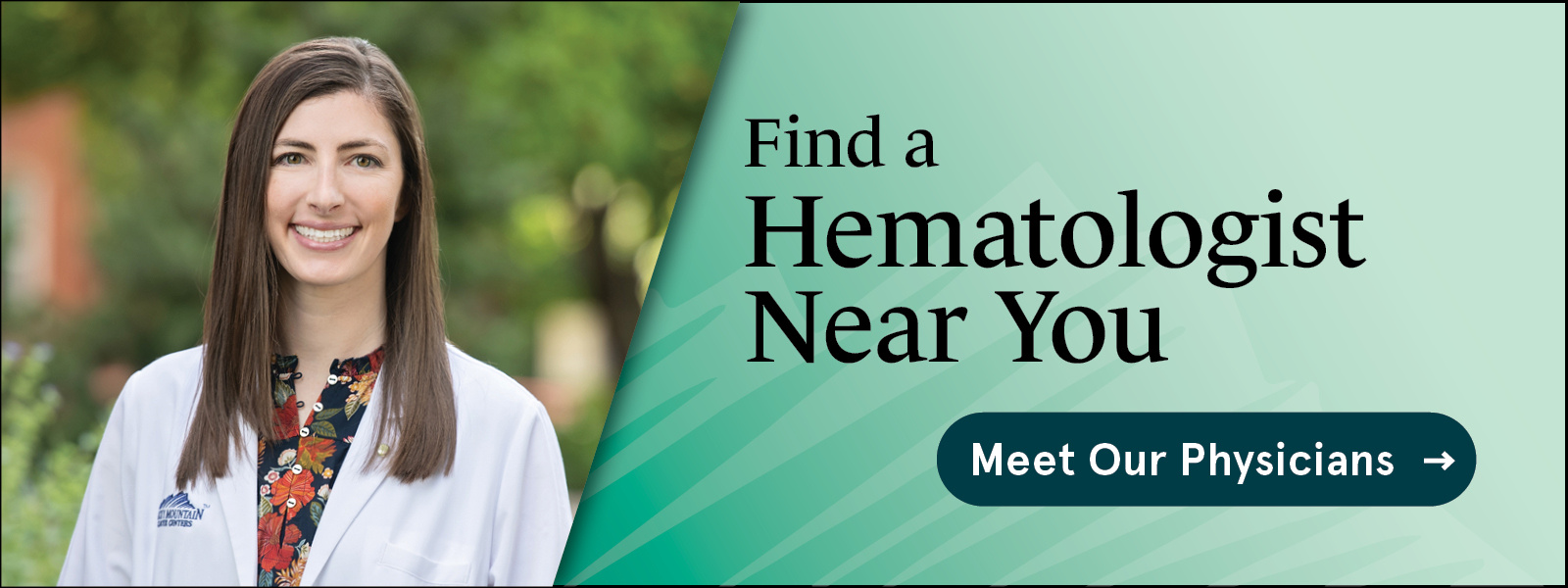Hodgkin Lymphoma
Receive Care from Colorado's Lymphoma Specialists
Trust the hematologic oncology specialists at Rocky Mountain Cancer Centers to create a customized treatment plan using the latest therapies available.

Hodgkin lymphoma develops when lymphocytes become abnormal. Lymphocytes are white blood cells formed in the bone marrow that travel through the blood and lymph fluid. There are two primary types of lymphocytes:
- B-Cells: B lymphocytes make antibodies that fight infection from bacteria and viruses.
- T-Cells: There are many types of T lymphocytes. Some T cells destroy germs or abnormal cells in the body. Other T cells help boost or slow the activity of other immune system cells.
The abnormal cell that develops, typically from a B cell, is called a Reed-Sternberg cell.
Reed-Sternberg cells divide quickly, making more and more abnormal cells. The abnormal cells don't die when they should and they don't protect the body from infections or other diseases. The buildup of abnormal cells often forms a tumor.
Most Hodgkin lymphomas begin in the upper body such as the chest, neck, and underarms where there are a lot of lymph nodes as well as organs related to your immune system such as the spleen, thymus, and digestive system.
Types of Hodgkin Lymphoma
There are different types of Hodgkin lymphoma. It is important to know the type you have because this may affect how the cancer is treated. Doctors determine the type of Hodgkin lymphoma based on how the cells look under a microscope and whether the cells contain certain abnormal proteins.Classic Hodgkin Lymphoma (cHL)
Classic Hodgkin lymphoma is the most common type of Hodgkin lymphoma. About 95% of cases of Hodgkin lymphoma are within the cHL category. cHL is divided into 4 subtypes, based on the appearance of the lymph node structure and cells:
Nodular sclerosis Hodgkin lymphoma is the most common subtype of cHL. It affects up to 80% of people diagnosed with cHL. Nodular sclerosis Hodgkin lymphoma is most common in young adults, especially women. In addition to Reed-Sternberg cells, there are bands of connective tissue (called fibrosis) found in the lymph node. The presence of these bands can help diagnose this type of Hodgkin lymphoma. This type of lymphoma often affects the lymph nodes in the central part of the chest, called the mediastinum.
About 6% of people with cHL are diagnosed with lymphocyte-rich classic Hodgkin lymphoma. It is more common in men and usually affects areas other than the mediastinum. In addition to Reed-Sternberg cells, the lymph node tissue contains many normal lymphocytes.
This subtype of cHL occurs most often in older adults. It sometimes develops in the abdomen and carries many different cell types, including large numbers of Reed-Sternberg cells.
Lymphocyte-depleted Hodgkin lymphoma is the least common subtype of cHL. Only about 1% of people with cHL have this subtype. It is most common in older adults; people with the human immunodeficiency virus (HIV), the virus that causes autoimmune deficiency syndrome (AIDS); and people in non-industrialized countries. The lymph node contains almost all Reed-Sternberg cells.
Nodular lymphocyte-predominant Hodgkin lymphoma
About 5% of people with Hodgkin lymphoma have nodular lymphocyte-predominant Hodgkin lymphoma. It often develops in the lymph nodes in the neck, groin, or armpit. It is most common in younger people. Some people with nodular lymphocyte-predominant Hodgkin lymphoma do not need treatment right away, while others may benefit from a treatment plan that includes radiation therapy, chemotherapy, or a monoclonal antibody.Signs & Symptoms of Hodgkin Lymphoma
While some people with lymphoma will experience obvious signs of the disease, others won’t notice any changes at all. Or, the cause of a symptom may be a different medical condition that is not cancer. Common symptoms or signs caused by Hodgkin lymphoma include:
Swelling
Fever
Weight Loss
Sweating
Pruritus
Fatigue
Pain
Cough
Hodgkin Lymphoma Risk Factors
The exact cause of Hodgkin lymphoma is not known, but the following factors may raise a person’s risk of developing Hodgkin lymphoma:
Age
Gender
Family History
Virus Exposure
How is Hodgkin Lymphoma Diagnosed?
If you have swollen lymph nodes or another symptom that suggests Hodgkin lymphoma, your doctor will try to find out what’s causing the problem. Your doctor may ask about your personal and family medical history.
You may have some of the following exams and tests:
-
Physical exam: Your doctor checks for swollen lymph nodes in your neck, underarms, and groin. Your doctor also checks for a swollen spleen or liver.
-
Blood tests: The lab does a complete blood count to check the number of white blood cells and other cells and substances.
-
Chest x-rays: X-ray pictures may show swollen lymph nodes or other signs of disease in your chest.
-
Biopsy: A biopsy is the only sure way to diagnose Hodgkin lymphoma. Your doctor may remove an entire lymph node (excisional biopsy) or only part of a lymph node (incisional biopsy). A thin needle (fine needle aspiration) usually cannot remove a large enough sample for the pathologist to diagnose Hodgkin lymphoma. Removing an entire lymph node is best.
The pathologist uses a microscope to check the tissue for Hodgkin lymphoma cells. A person with Hodgkin lymphoma usually has large, abnormal cells known as Reed-Sternberg cells. They are not found in people with non-Hodgkin lymphoma.
Hodgkin Lymphoma Staging
The hematologic oncologist considers the following to determine the stage of Hodgkin lymphoma:
- The number of lymph nodes that have Hodgkin lymphoma cells
- Whether these lymph nodes are on one or both sides of the diaphragm
- Whether the disease has spread to the bone marrow, spleen, liver, or lung.
The stages of Hodgkin lymphoma are as follows:
Stage I
Stage II
The lymphoma cells are in at least two lymph node groups on the same side of (either above or below) the diaphragm.
- Stage IIE: The lymphoma cells are in one part of a tissue or an organ and the lymph nodes near that organ (on the same side of the diaphragm). There may be lymphoma cells in other lymph node groups on the same side of the diaphragm.
- Stage II Bulky: Either stage II or stage IIE applies, plus there is a mass in the chest. The mass is either larger than one-third the diameter of the chest or larger than 10 centimeters (cm).
Stage III
Stage IV
Recurrent
Hodgkin Lymphoma Treatment Options
Your doctor can describe your treatment choices and the expected results. You and your doctor can work together to develop a treatment plan that meets your needs.
Your doctor may refer you to a specialist, or you may ask for a referral. Specialists who treat Hodgkin lymphoma include hematologists, medical oncologists, and radiation oncologists. Your doctor may suggest that you choose an oncologist who specializes in the treatment of Hodgkin lymphoma. Often, such doctors are associated with major academic centers. Your health care team may also include an oncology nurse and a registered dietitian.
The treatment plan depends mainly on the following:
- The type of your Hodgkin lymphoma (most people have classic Hodgkin lymphoma)
- Its stage (where the lymphoma is found)
- Whether you have a tumor that is more than 4 inches (10 centimeters) wide
- Your age
- Whether you’ve had weight loss, drenching night sweats, or fevers.
People with Hodgkin lymphoma may be treated with chemotherapy, radiation therapy, or both.
If Hodgkin lymphoma comes back after treatment, doctors call this a relapse or recurrence. These patients may receive high doses of chemotherapy, radiation therapy, or both, followed by bone marrow transplantation.
Chemotherapy
Chemotherapy for Hodgkin lymphoma uses drugs to kill lymphoma cells. It is called systemic therapy because the drugs travel through the bloodstream. The drugs can reach lymphoma cells in almost all parts of the body.
Usually, more than one drug is given. Most drugs for Hodgkin lymphoma are given through a vein (intravenous), but some are taken by mouth.
Chemotherapy is given in cycles. You have a treatment period followed by a rest period. The length of the rest period and the number of treatment cycles depend on the stage of your disease and on the anticancer drugs used.
You may have your treatment in a clinic, at the doctor’s office, or at home. Some people may need to stay in the hospital for treatment.
Bone Marrow Transplantation
If Hodgkin lymphoma returns after treatment, you may receive a bone marrow transplantation. A transplant of your own blood-forming stem cells (autologous) allows you to receive high doses of chemotherapy, radiation therapy, or both. The high doses destroy both Hodgkin lymphoma cells and healthy blood cells in the bone marrow.
Bone marrow transplants take place in the hospital. Before you receive high-dose treatment, your stem cells are removed and treated to kill lymphoma cells that may be present. Your stem cells are frozen and stored. After you receive high-dose treatment to kill Hodgkin lymphoma cells, your stored stem cells are thawed and given back to you through a flexible tube placed in a large vein in your neck or chest area. New blood cells develop from the transplanted stem cells.
Immunotherapy
Radiation Therapy
Radiation therapy (also called radiotherapy) for Hodgkin lymphoma uses high-energy rays to kill lymphoma cells. It can shrink tumors and help control pain.
A large machine aims the rays at the lymph node areas affected by lymphoma. This is local therapy because it affects cells in the treated area only. Most people go to a hospital or clinic for treatment 5 days a week for several weeks.
